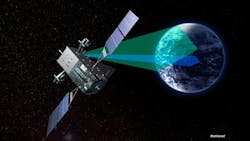Raytheon to develop infrared satellite sensor payload for DARPA Blackjack SATCOM and surveillance project
ARLINGTON, Va. – U.S. military researchers needed an overhead persistent infrared (OPIR) satellite sensor payload for a constellation of small, secure, and affordable military satellites that capitalize on modern commercial satellite technologies. They found their solution from Raytheon Technologies Corp.
Officials of the U.S. Defense Advanced Research Projects Agency (DARPA) in Arlington, Va., announced a $37.4 million contract Friday to the Raytheon Intelligence & Space segment in El Segundo, Calif., to build and demonstrate an OPIR sensor payload for the Blackjack project.
Raytheon will design, fabricate, test, and deliver in quantity space-flight ready infrared sensor payloads capable of integrating with multiple Blackjack buses and Pit Boss subsystem supporting an on-orbit constellation level demonstration.
Blackjack seeks to develop low-cost space payloads and commoditized satellite buses with low size, weight, power, and cost (SWaP-C) with similar capabilities to today’s military communications that operate at geosynchronous orbit (GEO), but at a fraction of the cost.
This project is devising ways to mix and match commercial satellite buses and military satellite communications (SATCOM) and reconnaissance payloads as late in the Blackjack design process as possible to develop low-Earth-orbit (LEO) satellites based on commercial satellite technologies.
Blackjack satellite payloads will include OPIR sensors; positioning, navigation, and timing (PNT) payloads; Global Positioning System (GPS) augmentation; RF and optical tactical communications; tactical intelligence, surveillance, and reconnaissance payloads; and all-weather multi-domain geolocation, identification, characterization, and tracking.
Raytheon is joining other Blackjack contractors in efforts to enable the Blackjack architecture to integrate several types of commercial satellite buses easily with a wide range of militarily payloads.
DARPA researchers are interested in SATCOM payloads, as well as those that can detect, identify, and track advanced missile threats; and provide space-based surface moving target indication.
Pairing different buses and payloads late in the satellite design process could enable U.S. military leaders to deploy and integrate small and inexpensive communications and reconnaissance satellites quickly in LEO without modifying the architecture.
Blackjack will capitalize on open-architecture standards and system controls to enable easy insertion of third-party software and hardware, including space-based payloads and hosted applications, communications equipment, and surface-based user devices and software.
To reduce integration risk, Blackjack also is developing an avionics unit called Pit Boss for each spacecraft with high-speed processor and encryption devices that will function as a common network and electrical interface.
Pit Boss is providing a common electrical interface to each payload, as well as mission-level autonomy, on-orbit edge computing, communication between Blackjack satellites and ground users, and a command and telemetry link to the bus, and encrypt payload data.
Blackjack’s expected 20-satellite demonstration will emulate a 90-satellite functional layer. A 20-satellite combination of two orbital planes of 10 satellites each will fly in 2021 or 2022 to demonstrate low-cost sensor capabilities, real-time on-orbit payload processing, low-latency global connectivity using a commercial data transport layer, and Pit Boss autonomy.
Within the Blackjack program, DARPA envisions five separate categories of contracts for commoditized buses; payloads; constellation-level autonomy; node integration; and launch and operations.
DARPA officials have awarded Blackjack contracts to Trident Systems Inc. in Fairfax, Va., and Airbus Defense and Space Inc. in Herndon, Va., to develop small and power-efficient military communications and surveillance satellites designed to operate in LEO.
Blue Canyon Technologies in Boulder, Colo., is developing low-cost space payloads and commoditized satellite buses for Blackjack with similar capabilities as today's military communications that operate at geosynchronous orbit (GEO), but at a fraction of the cost.
SEAKR Engineering Inc. in Centennial, Colo., is developing the Blackjack Pit Boss. The Lockheed Martin Corp. Space Systems segment in Sunnyvale, Calif., is managing interfaces between Blackjack’s satellite buses, payloads, and Pit Boss data processor.
On Friday's contract, Raytheon will do the work on the Blackjack OPIR sensor payloads in El Segundo, Calif., and should be finished by April 2023. For more information contact Raytheon Intelligence & Space online at www.raytheonintelligenceandspace.com, or DARPA at www.darpa.mil.
About the Author
John Keller
Editor-in-Chief
John Keller is the Editor-in-Chief, Military & Aerospace Electronics Magazine--provides extensive coverage and analysis of enabling electronics and optoelectronic technologies in military, space and commercial aviation applications. John has been a member of the Military & Aerospace Electronics staff since 1989 and chief editor since 1995.
